Input interpretation

1, 1, 1, 2-tetrachloroethane
Chemical names and formulas
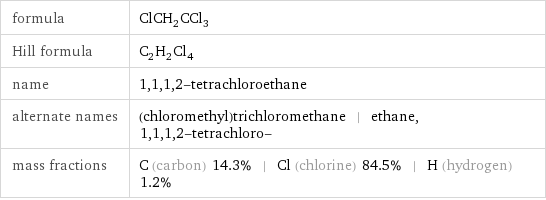
formula | ClCH_2CCl_3 Hill formula | C_2H_2Cl_4 name | 1, 1, 1, 2-tetrachloroethane alternate names | (chloromethyl)trichloromethane | ethane, 1, 1, 1, 2-tetrachloro- mass fractions | C (carbon) 14.3% | Cl (chlorine) 84.5% | H (hydrogen) 1.2%
Lewis structure
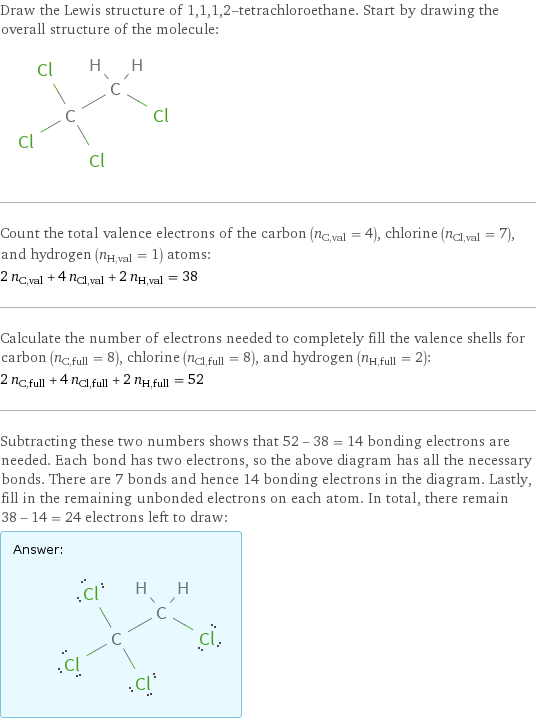
Draw the Lewis structure of 1, 1, 1, 2-tetrachloroethane. Start by drawing the overall structure of the molecule: Count the total valence electrons of the carbon (n_C, val = 4), chlorine (n_Cl, val = 7), and hydrogen (n_H, val = 1) atoms: 2 n_C, val + 4 n_Cl, val + 2 n_H, val = 38 Calculate the number of electrons needed to completely fill the valence shells for carbon (n_C, full = 8), chlorine (n_Cl, full = 8), and hydrogen (n_H, full = 2): 2 n_C, full + 4 n_Cl, full + 2 n_H, full = 52 Subtracting these two numbers shows that 52 - 38 = 14 bonding electrons are needed. Each bond has two electrons, so the above diagram has all the necessary bonds. There are 7 bonds and hence 14 bonding electrons in the diagram. Lastly, fill in the remaining unbonded electrons on each atom. In total, there remain 38 - 14 = 24 electrons left to draw: Answer: | |
3D structure

3D structure
Basic properties
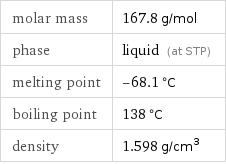
molar mass | 167.8 g/mol phase | liquid (at STP) melting point | -68.1 °C boiling point | 138 °C density | 1.598 g/cm^3
Units

Liquid properties (at STP)
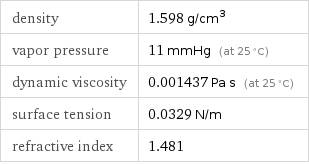
density | 1.598 g/cm^3 vapor pressure | 11 mmHg (at 25 °C) dynamic viscosity | 0.001437 Pa s (at 25 °C) surface tension | 0.0329 N/m refractive index | 1.481
Units

Thermodynamic properties
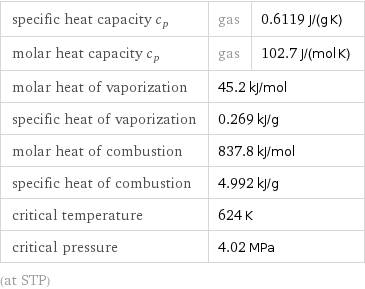
specific heat capacity c_p | gas | 0.6119 J/(g K) molar heat capacity c_p | gas | 102.7 J/(mol K) molar heat of vaporization | 45.2 kJ/mol | specific heat of vaporization | 0.269 kJ/g | molar heat of combustion | 837.8 kJ/mol | specific heat of combustion | 4.992 kJ/g | critical temperature | 624 K | critical pressure | 4.02 MPa | (at STP)
Chemical identifiers
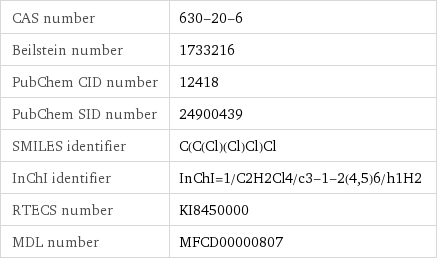
CAS number | 630-20-6 Beilstein number | 1733216 PubChem CID number | 12418 PubChem SID number | 24900439 SMILES identifier | C(C(Cl)(Cl)Cl)Cl InChI identifier | InChI=1/C2H2Cl4/c3-1-2(4, 5)6/h1H2 RTECS number | KI8450000 MDL number | MFCD00000807
Safety properties

flash point | 36 °C lower explosive limit | 4.9% (concentration in air) upper explosive limit | 12.1% (concentration in air)

DOT hazard class | 6.1 DOT numbers | 1702